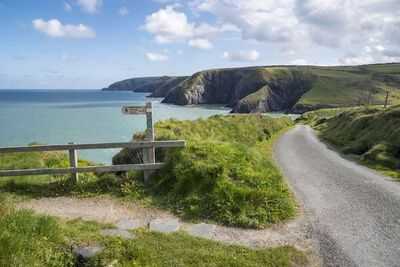A beautiful county is perfect for visitors and way less crowded than nearby alternatives. Pembrokeshireis in southwest Wales and receives only six million visitors a year. This is tiny compared to the tens of millions who visit Cornwall and Devon every year.
Visitors can explore one of the smallest national parks, the Pembrokeshire Coast, which makes up a third of the county. It is known for its thriving wetlands, woodland, and beaches. Wildlife to be spotted includes gannets, puffins, Manx shearwaters, razorbills, guillemots, kittiwakes, and fulmars. It is also a hub for seals, with approximately 5,000 Atlantic grey seals in the waters around Pembrokeshire. They can be seen swimming around the coast at any time of year and come ashore to moult in the winter and early spring, and females come ashore to pup in the autumn. There are many prehistoric sites in Pembrokeshire, particularly in the Preseli Mountains. During the Middle Ages, several castles were built by the Normans, including Pembroke and Cilgerran, and St. David's Cathedral became an important pilgrimage site.

There are reminders of the area's industrial tradition with small quays, lime kilns and warehouses, and sites like the brickworks at Porthgain.
The National Park includes many areas which are of nature conservation significance in their own right, including seven Special Areas of Conservation, a Marine Nature Reserve, six national nature reserves and 75 Sites of Special Scientific Interest.
Ancient woodland still exists, such as T Canol Wood, where biofluorescence, seen under ultraviolet light under the dark sky, is a feature that has led to the wood being described as "...one of the most magical and special woodlands in the UK."
In the north of the county are the Preseli Mountains, a vast expanse of high moorland that supports sheep farming and some forestry, with numerous prehistoric sites and the probable source of the bluestones used in the construction of the inner circle of Stonehenge.
The Pembrokeshire Coast 200 allows visitors to see this under-visited part of the UK, often overshadowed by the more famous North Coast 500 in Scotland.
It takes drivers along Cardigan Bay on the west coast of Wales, from Dolgellau to St David's, in a journey of just under 200km (124 miles). The route topped a list of the most underrated road trips in Europe, compiled by Vixa from the AA.
Also on this coast is the Pembrokeshire Coast Path. The route stretches from 180 miles from St Dogmaels in the north to Amroth in the south. It would take around 12 days to complete, travelling 15 miles a day.
It is well-signposted throughout. The distinctive acorn symbol, used by all the English and Welsh National Trails, is on stiles, gates, signposts, and lampposts throughout towns.
You may also like

'We've quit Britain for beautiful island three hours away with barely any tax'

Kashmiri doctor held in Faridabad, over 360 kg of explosives, weapons recovered

'I've done one thing every weekend in my Fiat 500 for 3 years'

Nishant Singh Malkani clears the air on Ashnoor Kaur's viral clip, refutes link to Abhishek Bajaj

Watch: Passenger films bizarre bath on train; railways identifies man, takes action







